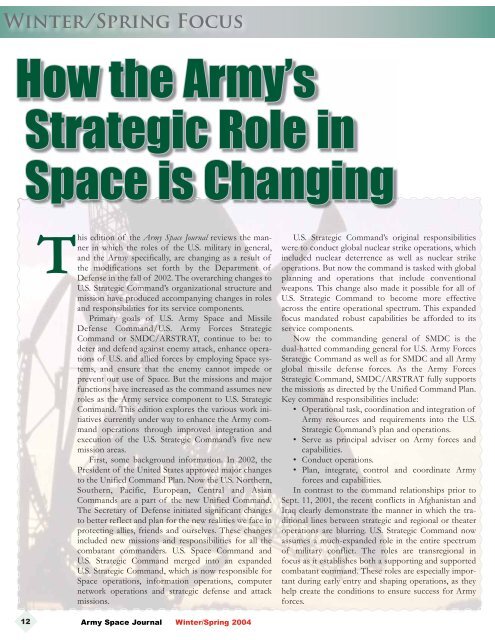Volume 3, Number 1 - Space and Missile Defense Command - U.S. ...
Volume 3, Number 1 - Space and Missile Defense Command - U.S. ...
Volume 3, Number 1 - Space and Missile Defense Command - U.S. ...
Create successful ePaper yourself
Turn your PDF publications into a flip-book with our unique Google optimized e-Paper software.
How the Army’s<br />
Strategic Role in<br />
<strong>Space</strong> is Changing<br />
This edition of the Army <strong>Space</strong> Journal reviews the manner<br />
in which the roles of the U.S. military in general,<br />
<strong>and</strong> the Army specifically, are changing as a result of<br />
the modifications set forth by the Department of<br />
<strong>Defense</strong> in the fall of 2002. The overarching changes to<br />
U.S. Strategic Comm<strong>and</strong>’s organizational structure <strong>and</strong><br />
mission have produced accompanying changes in roles<br />
<strong>and</strong> responsibilities for its service components.<br />
Primary goals of U.S. Army <strong>Space</strong> <strong>and</strong> <strong>Missile</strong><br />
<strong>Defense</strong> Comm<strong>and</strong>/U.S. Army Forces Strategic<br />
Comm<strong>and</strong> or SMDC/ARSTRAT, continue to be: to<br />
deter <strong>and</strong> defend against enemy attack, enhance operations<br />
of U.S. <strong>and</strong> allied forces by employing <strong>Space</strong> systems,<br />
<strong>and</strong> ensure that the enemy cannot impede or<br />
prevent our use of <strong>Space</strong>. But the missions <strong>and</strong> major<br />
functions have increased as the comm<strong>and</strong> assumes new<br />
roles as the Army service component to U.S. Strategic<br />
Comm<strong>and</strong>. This edition explores the various work initiatives<br />
currently under way to enhance the Army comm<strong>and</strong><br />
operations through improved integration <strong>and</strong><br />
execution of the U.S. Strategic Comm<strong>and</strong>’s five new<br />
mission areas.<br />
First, some background information. In 2002, the<br />
President of the United States approved major changes<br />
to the Unified Comm<strong>and</strong> Plan. Now the U.S. Northern,<br />
Southern, Pacific, European, Central <strong>and</strong> Asian<br />
Comm<strong>and</strong>s are a part of the new Unified Comm<strong>and</strong>.<br />
The Secretary of <strong>Defense</strong> initiated significant changes<br />
to better reflect <strong>and</strong> plan for the new realities we face in<br />
protecting allies, friends <strong>and</strong> ourselves. These changes<br />
included new missions <strong>and</strong> responsibilities for all the<br />
combatant comm<strong>and</strong>ers. U.S. <strong>Space</strong> Comm<strong>and</strong> <strong>and</strong><br />
U.S. Strategic Comm<strong>and</strong> merged into an exp<strong>and</strong>ed<br />
U.S. Strategic Comm<strong>and</strong>, which is now responsible for<br />
<strong>Space</strong> operations, information operations, computer<br />
network operations <strong>and</strong> strategic defense <strong>and</strong> attack<br />
missions.<br />
U.S. Strategic Comm<strong>and</strong>’s original responsibilities<br />
were to conduct global nuclear strike operations, which<br />
included nuclear deterrence as well as nuclear strike<br />
operations. But now the comm<strong>and</strong> is tasked with global<br />
planning <strong>and</strong> operations that include conventional<br />
weapons. This change also made it possible for all of<br />
U.S. Strategic Comm<strong>and</strong> to become more effective<br />
across the entire operational spectrum. This exp<strong>and</strong>ed<br />
focus m<strong>and</strong>ated robust capabilities be afforded to its<br />
service components.<br />
Now the comm<strong>and</strong>ing general of SMDC is the<br />
dual-hatted comm<strong>and</strong>ing general for U.S. Army Forces<br />
Strategic Comm<strong>and</strong> as well as for SMDC <strong>and</strong> all Army<br />
global missile defense forces. As the Army Forces<br />
Strategic Comm<strong>and</strong>, SMDC/ARSTRAT fully supports<br />
the missions as directed by the Unified Comm<strong>and</strong> Plan.<br />
Key comm<strong>and</strong> responsibilities include:<br />
• Operational task, coordination <strong>and</strong> integration of<br />
Army resources <strong>and</strong> requirements into the U.S.<br />
Strategic Comm<strong>and</strong>’s plan <strong>and</strong> operations.<br />
• Serve as principal adviser on Army forces <strong>and</strong><br />
capabilities.<br />
• Conduct operations.<br />
• Plan, integrate, control <strong>and</strong> coordinate Army<br />
forces <strong>and</strong> capabilities.<br />
In contrast to the comm<strong>and</strong> relationships prior to<br />
Sept. 11, 2001, the recent conflicts in Afghanistan <strong>and</strong><br />
Iraq clearly demonstrate the manner in which the traditional<br />
lines between strategic <strong>and</strong> regional or theater<br />
operations are blurring. U.S. Strategic Comm<strong>and</strong> now<br />
assumes a much-exp<strong>and</strong>ed role in the entire spectrum<br />
of military conflict. The roles are transregional in<br />
focus as it establishes both a supporting <strong>and</strong> supported<br />
combatant comm<strong>and</strong>. These roles are especially important<br />
during early entry <strong>and</strong> shaping operations, as they<br />
help create the conditions to ensure success for Army<br />
forces.<br />
12<br />
Army <strong>Space</strong> Journal Winter/Spring 2004

















